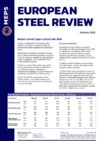UK steel market cautiously optimistic for 2022
Many UK steel suppliers will be heading into 2022 in confident mood, after posting impressive financial results during the past twelve months.
Domestic steel producers, and most local stockholders, were major beneficiaries of the upward pricing trajectory, across all finished steel products. The price gains for long products were smaller than those for strip mill items. Nevertheless, prices in both segments were significantly higher, in December, than those at the beginning of 2021.
In many steel-consuming sectors, UK end-users had little option but to pay more for their material, owing to supply-side difficulties.
When the UK economy reopened after the initial Covid-19-related lockdown, domestic companies struggled to keep pace with the increase in activity. Steel manufacturers, not just in the UK but worldwide, were slow to reintroduce capacity that had been withdrawn at the onset of the pandemic. Moreover, major producer, Liberty Steel, curtailed production at several of its sites, amid financial troubles.
Many purchasing managers in the United Kingdom reported that their buying options, from overseas, were limited. Global steel producers had reduced need to export, due to recovering demand in their domestic markets. Import restrictions, through tariff-rate quotas, were also a discouraging factor.
Furthermore, problems in global supply chains were evident. A spike in freight costs developed and a lack of available transport disrupted traditional trade flows into the country. Congestion at many local ports, due to Covid-19-related staff shortages, and greater administrative complexities, resulting from Britain’s withdrawal from the European Union, encouraged domestic buyers to seek local supply.
Steel producers in the UK, as in the rest of Europe, had ‘carte blanche’ to raise their list prices – and they did so, with alarming regularity, from the perspective of steel buyers.
Aside from a seasonal downturn in the fourth quarter, UK steel manufacturers will be aiming to ride the pricing wave, in early 2022. However, the success of this is far from certain.
Domestic long product mills took steps to recoup the rapid rise in gas and electricity costs, by introducing a temporary energy surcharge for new orders. This will be imposed in the first quarter of 2022, either as a standalone extra or as part of a basis price rise. Nevertheless, several buyers reported, in December, that the surcharge had been waived, or only partly accepted.
An increase in restocking activity is projected, this month, following the end of the calendar year. A surge in Covid-19 Omicron variant cases, however, could weigh heavily on sentiment. Rising inflationary pressures may also constrain an upturn in market activity.
The Bank of England’s decision to raise interest rates, for the first time in more than three years, is likely to have a dampening effect on steel consumption projections, in the early part of this year. A slowdown in the property market and delays in new investments are two scenarios that may develop.
MEPS predicts that UK long product prices will rise, in the next few months, due to the sharp escalation in the mills’ energy costs. However, a downward correction is anticipated, later in 2022. It is widely acknowledged that the extent of short-term price volatility will depend not only on traditional steel market dynamics, but also on developments in the wider UK economy.

Source:
European Steel Review
The MEPS European Steel Review is an informative, concise and easy-to-use monthly publication, offering unique professional insight into European carbon steel prices.
Go to productRequest a free publication





